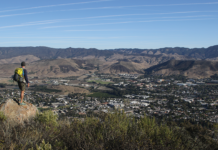connects kids to their natural world.
By Kit Stolz
avid White, a biologist and educator, leads the Once Upon a Watershed environmental education group that works to connect school children in Ojai and Ventura with their watershed around the Ventura River, using as much exploration and hands-on experience as possible.
For White, the learning from nature he shares with kids goes back to his own boyhood. He thinks of the River Dee.
Though little known to Americans, this is a long and legendary river, which flows from its source in the high Cairngorms mountain range in Scotland, past Queen Elizabeth II’s beloved Balmoral Castle and eventually out to the North Sea through urbanized neighborhoods in Aberdeen, where White grew up.
As a boy White liked to go down to that river.
“When I trace back my interest in biology, I look back at what I did when I was a kid, and when I was a kid the River Dee was within easy walking distance of my house. We would go down and play in the river, hunt stickleback [fish] and eels. This was a tidal river and a big salmon river. I had a lot of unstructured nature time with the River Dee.”
When White first came to Ventura County in the early 1990s, he connected with the Sespe River, which flows through the Los Padres National Forest backcountry, just as he had with the River Dee, and he feels a similar connection today for the Ventura River. But to make this outdoor education program possible meant finding funding. That means writing grants. Fortunately, he says, when he was a graduate student in Edinburgh and post-graduate researcher in New York, specializing in microscopy and cell biology, he learned that to be successful as a scientist meant writing grants to find funding to stay employed as a scientist.
“Part of the training I got as a researcher is about grant writing. A lot of post-doctoral research is funded by soft money, and accessing that is about grant writing, and so I wrote grants when I was working in labs and running labs in Edinburgh and at Cornell and the University of Idaho,” White said. ‘When I started teaching biology at Happy Valley School in Upper Ojai [now Besant Hill School of Happy Valley] it was a natural transition to writing grants for educational fund-raising.”
White taught at a number of schools, including Ojai Valley School and Oak Grove, and always liked finding ways to take his biology classes out of doors. He first worked for Once Upon a Watershed shortly after its founder, Sarah Brooke-Benjamin — whom White describes as an “inspired” educator and grant writer — won a federal government grant for an afterschool program for four Ojai Valley Schools. She launched Once Upon a Watershed 15 years ago. White began by volunteering to bring kids from Ojai Valley School into the program.
Not long after, around 2006, White met Derek Poultney, who at the time was working at the Ojai Valley Land Conservancy.
“We were doing wetlands restoration at Besant Meadows Preserve,” said Poultney. “He was teaching biology and propagating native seeds and we would consult with him on where to find native seeds for restoration projects.”
Among those native seeds were acorns that children working with Once Upon a Watershed gathered, propagated and planted in the preserve. Today White and other educators still lead classes in the preserve, sometimes teaching in the shade of young oaks planted by earlier generations of children in the program.
Despite its success, Once Upon a Watershed found itself in the fiscal wilderness in recent years, due to the cost of health insurance, worker’s compensation insurance and other legal protections for its handful of staff under new state regulations, long after Brooke-Benjamin moved on. To solve this problem, White reconnected with his associate and friend Poultney, who had in the meantime become executive director of the Ventura Land Trust (VLT), which has made education about Ventura lands central to its mission.
“One reason why it’s such a good fit is that we have been concentrating on educating in 7th grade and on up all the way to college, with training through an advanced environmental educational program for college students. Once Upon a Watershed focuses on K-6,” Poultney said. He adds that the collaboration allows Once Upon a Watershed to expand beyond schools in Ojai, to schools in Ventura such as E.P. Foster, De Anza, Ventura Charter School and Sunset.
The program still raises its own operating funds, Poultney stresses, and pays VLT for its costs, mostly through grants. Now, however, it can properly employ teachers, drivers and aides under the legal and financial umbrella provided by VLT. Most importantly for both White
and Poultney, the organizations agree on the mission.
“At the core it’s about connecting kids with nature,” White said. “How can we expect the next generation to care for nature if they don’t know what it is? We try to get the kids to think about the questions they ask. We don’t want to tell them the names of plants, because that’s meaningless to them. Instead we’ll use a whole bunch of sensory inputs. We’ll use our ‘raccoon touch’ to feel a plant, we’ll use our ‘deer ears’ to listen to the watershed, our ‘coyote sense’ of smell, our ‘eagle eye.’ We want the kids to appreciate the natural world using all of their senses. We’re not trying to teach about nature, we’re trying to learn from nature.”
“His particular style is very interactive,” Poultney said. “His latest technique is to have the kids pretend to be objects in the river when it floods. What does it feel like to be a tree when the water level rises? What does it feel like to be a rock when the water picks it up — where does it take them? For many kids, it’s the first time they’ve been to the river, even if they live just a quarter-mile away. And it’s true we all depend on the river and the watershed, just like the animals who live there, and we all need to take care of it, because it provides us with so many things we need.”
Shari Usher, a teacher at Matilija Junior High School who has been working with White for many years in Once Upon a Watershed, speaks of how well prepared White is to lead kids of all ages into the watershed, building on ideas first introduced in the classroom.
“David has a really nice way with the kids,” she said. “He’s patient and knowledgeable, and he knows the material so well that he can flow with whatever questions come up. I feel as if he’s a model for a lot of us, one of those people who can talk the talk and walk the walk. He believes in what he’s doing, and he’s very passionate about it. He’s always asking how we can find new ways to connect kids to nature.”
For his part, White is thrilled to see Once Upon a Watershed expand beyond its base in Ojai into Ventura and beyond. His teachers have begun to work with the new Rio Del Sol School in Oxnard, for one, and he and his staff have been hearing from parents and teachers at other schools interested in the program.
“I think there’s increasingly an acknowledgement of the importance of connecting with nature,” White said. “I hear from students who are concerned about our climate emergency. They’re saying: What can we do? Being able to plant trees is something we can do. It’s a nature-based climate solution, and that’s a core thing for us, planting trees with kids.”




























